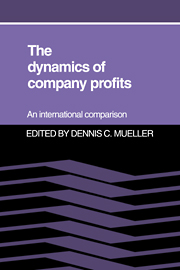Book contents
- Frontmatter
- Contents
- Preface
- Contributors
- 1 Profits and the process of competition
- 2 Modeling persistent profitability
- 3 The persistence of profits in the United States
- 4 The persistence of profits in U.S. manufacturing industries
- 5 The persistence of profitability in Canada
- 6 The persistence of corporate profits in the Federal Republic of Germany
- 7 The persistence of profits in France
- 8 The persistence of profits in Japan
- 9 The persistence of profits in the United Kingdom
- 10 The persistence of profits: international comparison
- 11 The persistence of profits in perspective
- References
- Index
5 - The persistence of profitability in Canada
Published online by Cambridge University Press: 03 May 2010
- Frontmatter
- Contents
- Preface
- Contributors
- 1 Profits and the process of competition
- 2 Modeling persistent profitability
- 3 The persistence of profits in the United States
- 4 The persistence of profits in U.S. manufacturing industries
- 5 The persistence of profitability in Canada
- 6 The persistence of corporate profits in the Federal Republic of Germany
- 7 The persistence of profits in France
- 8 The persistence of profits in Japan
- 9 The persistence of profits in the United Kingdom
- 10 The persistence of profits: international comparison
- 11 The persistence of profits in perspective
- References
- Index
Summary
Introduction
The state of competition and pace of adjustment are frequent themes in public policy discussions regarding Canadian industry. Compared with other Western industrialized countries, Canadian industry tends to be highly concentrated, and domestic markets are generally small relative to efficient scale of production and subject to tariff protection. Over the past decade or so, however, the trends toward increased industry concentration have been less marked, tariffs have on average been reduced to half their pre-1970 levels, and import competition pressures have been exerted in a wide spectrum of markets (see Khemani, 1986). Negotiations for bilateral free trade between Canada and the United States are also currently under way.
In light of these developments, it is of some interest to examine the trend of corporate profits over time. To the extent that the competitive process is relatively fast, profits above or below the competitive norm should disappear (allowing for factors such as uncertainty, innovations, and changes in tastes). If, however, profits persist over time, they may be indicative of impediments in the competitive process such as barriers to entry and oligopolistic coordination of firm price–output policies.
In this chapter, we first measure the extent of persistence in long-run profits of large Canadian corporations over the period 1964–82. We then examine the determinants of these profits and the role played by entry and exit of firms in the adjustment process. Our conclusions are that the competitive process does work in pushing profit rates toward the competitive norm but it does not succeed in equalizing profit rates.
- Type
- Chapter
- Information
- The Dynamics of Company Profits , pp. 77 - 104Publisher: Cambridge University PressPrint publication year: 1990
- 14
- Cited by



